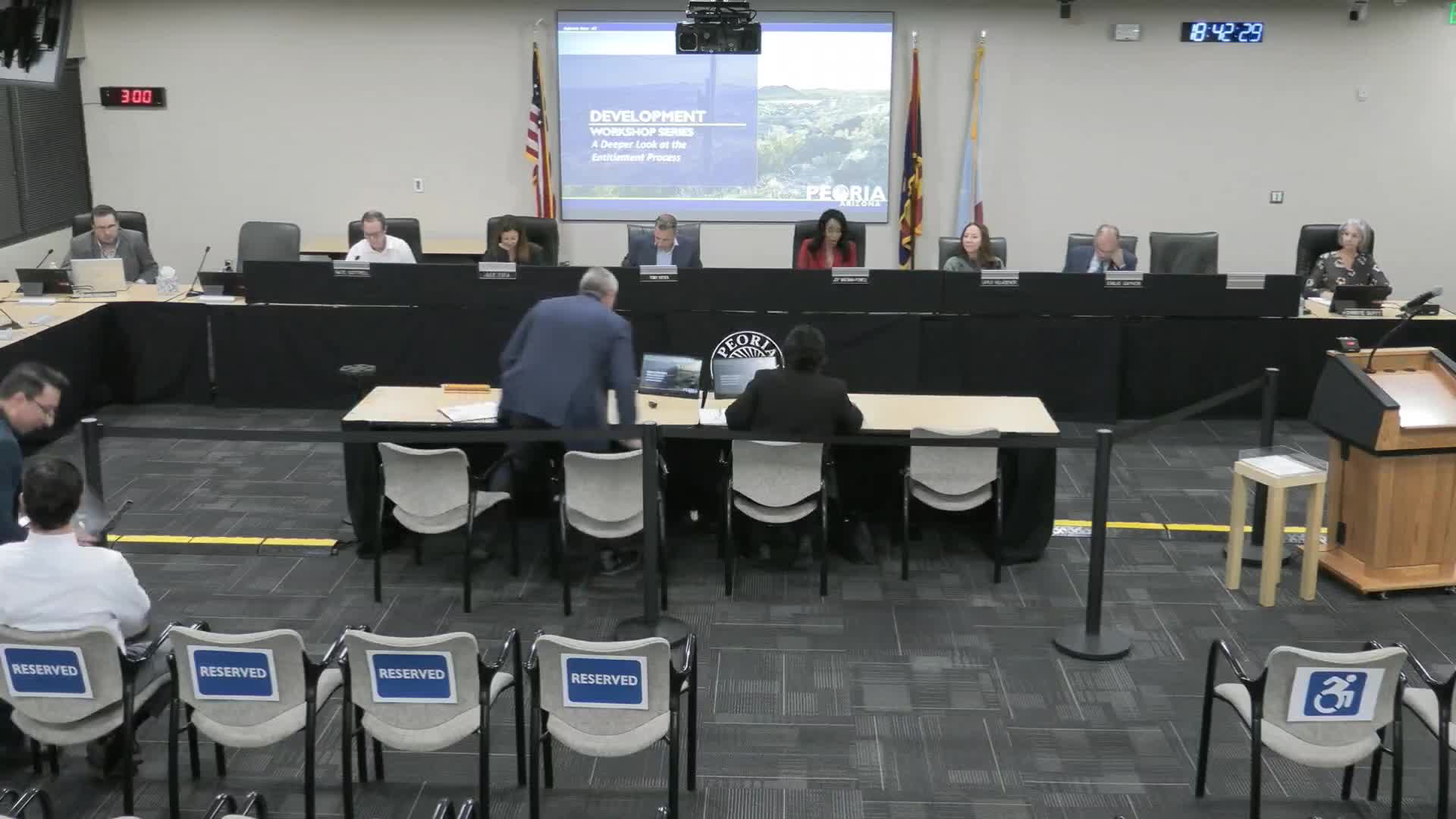Peoria planning staff holds deep-dive on entitlement process: general plan, SAPs, rezones and PADs
October 17, 2025 | Peoria, Maricopa County, Arizona
This article was created by AI summarizing key points discussed. AI makes mistakes, so for full details and context, please refer to the video of the full meeting. Please report any errors so we can fix them. Report an error »

City of Peoria planning staff on Oct. 16 gave commissioners a detailed "development workshop" explaining the entitlement process, the difference between the general plan and zoning, the role of specific area plans (SAPs), and the rezoning process including planned area developments (PADs) and planned community districts (PCDs).
"This is a policy document," presenter Miss Deaver said of the general plan, describing it as the city's long-range vision and distinguishing it from regulatory zoning. "It encompasses the municipal planning area, which extends beyond the city limits. It's what do we wanna be as a city when we grow up, the full extent. It is looking out 10 to 20 years beyond." The presentation emphasized that the general plan uses aspirational language and that the city council is the decision body for plan amendments.
Staff walked commissioners through multiple common misconceptions. Among the clarifications: a property's zoning—not the general plan map alone—determines what uses may proceed immediately; a general plan or SAP cannot retroactively extinguish established property rights; and PADs/PCDs are custom zoning tools used to implement the general plan but are distinct from the general plan itself. Staff also noted Peoria currently has nine specific area plans, some adopted as early as 1999 and as recently as 2014, and that outdated SAPs risk becoming obsolete if not updated.
The workshop covered procedural distinctions in practice: entitlement (the legal right to develop land, including rezonings and general plan amendments) versus permitting (construction approvals and code compliance); initial zoning for annexed land; minor and major amendments; and who decides what at each stage. Staff reiterated that zoning decisions must not be "arbitrary or capricious" and must be based on code criteria.
Commissioners asked practical questions that staff addressed with examples and scenarios. Staff walked through three scenarios (a grocery-anchored commercial center proposed on land with a conflicting general plan designation; an employment center inside a master-planned community; and a 150-unit subdivision on a recently annexed parcel) and explained the required processes for each. When feasibility and public expectations were discussed, staff said the city cannot "pick winners and losers" by favoring specific named businesses; zoning categories describe types of uses, not brands.
Commissioners praised the workshop as useful training. Director Hockas and Miss Deaver said the department will consider producing brief one-page summaries of key planning concepts for public distribution and to help commissioners in high-attention cases.
No formal action was required or taken on the workshop; commissioners heard the presentation and asked clarifying questions for later use in deliberations on development cases.
"This is a policy document," presenter Miss Deaver said of the general plan, describing it as the city's long-range vision and distinguishing it from regulatory zoning. "It encompasses the municipal planning area, which extends beyond the city limits. It's what do we wanna be as a city when we grow up, the full extent. It is looking out 10 to 20 years beyond." The presentation emphasized that the general plan uses aspirational language and that the city council is the decision body for plan amendments.
Staff walked commissioners through multiple common misconceptions. Among the clarifications: a property's zoning—not the general plan map alone—determines what uses may proceed immediately; a general plan or SAP cannot retroactively extinguish established property rights; and PADs/PCDs are custom zoning tools used to implement the general plan but are distinct from the general plan itself. Staff also noted Peoria currently has nine specific area plans, some adopted as early as 1999 and as recently as 2014, and that outdated SAPs risk becoming obsolete if not updated.
The workshop covered procedural distinctions in practice: entitlement (the legal right to develop land, including rezonings and general plan amendments) versus permitting (construction approvals and code compliance); initial zoning for annexed land; minor and major amendments; and who decides what at each stage. Staff reiterated that zoning decisions must not be "arbitrary or capricious" and must be based on code criteria.
Commissioners asked practical questions that staff addressed with examples and scenarios. Staff walked through three scenarios (a grocery-anchored commercial center proposed on land with a conflicting general plan designation; an employment center inside a master-planned community; and a 150-unit subdivision on a recently annexed parcel) and explained the required processes for each. When feasibility and public expectations were discussed, staff said the city cannot "pick winners and losers" by favoring specific named businesses; zoning categories describe types of uses, not brands.
Commissioners praised the workshop as useful training. Director Hockas and Miss Deaver said the department will consider producing brief one-page summaries of key planning concepts for public distribution and to help commissioners in high-attention cases.
No formal action was required or taken on the workshop; commissioners heard the presentation and asked clarifying questions for later use in deliberations on development cases.
View the Full Meeting & All Its Details
This article offers just a summary. Unlock complete video, transcripts, and insights as a Founder Member.
✓
Watch full, unedited meeting videos
✓
Search every word spoken in unlimited transcripts
✓
AI summaries & real-time alerts (all government levels)
✓
Permanent access to expanding government content
30-day money-back guarantee

